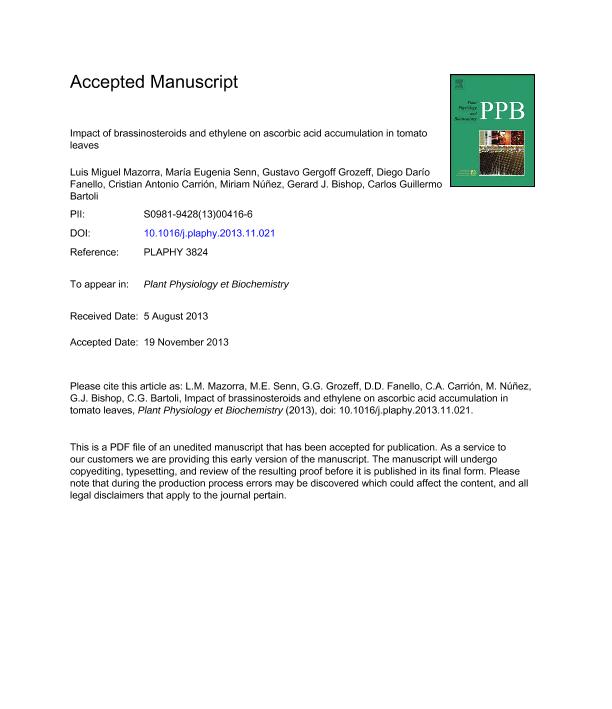Artículo
Impact of brassinosteroids and ethylene on ascorbic acid accumulation in tomato leaves
Mazorra Morales, Luis Miguel ; Senn, María Eugenia
; Senn, María Eugenia ; Gergoff Grozeff, Gustavo Esteban
; Gergoff Grozeff, Gustavo Esteban ; Fanello, Diego Darío
; Fanello, Diego Darío ; Carrión, Cristian Antonio
; Carrión, Cristian Antonio ; Núñez, Miriam; Bishop, Gerard James; Bartoli, Carlos Guillermo
; Núñez, Miriam; Bishop, Gerard James; Bartoli, Carlos Guillermo
 ; Senn, María Eugenia
; Senn, María Eugenia ; Gergoff Grozeff, Gustavo Esteban
; Gergoff Grozeff, Gustavo Esteban ; Fanello, Diego Darío
; Fanello, Diego Darío ; Carrión, Cristian Antonio
; Carrión, Cristian Antonio ; Núñez, Miriam; Bishop, Gerard James; Bartoli, Carlos Guillermo
; Núñez, Miriam; Bishop, Gerard James; Bartoli, Carlos Guillermo
Fecha de publicación:
01/2014
Editorial:
Elsevier France-editions Scientifiques Medicales Elsevier
Revista:
Plant Physiology and Biochemistry
ISSN:
0981-9428
Idioma:
Inglés
Tipo de recurso:
Artículo publicado
Clasificación temática:
Resumen
Plant steroid hormones brassinosteroids (BRs) and the gaseous hormone ethylene (ET) alter the ascorbic acid - glutathione (AA-GSH) levels in tomato (Solanum lycopersicum L.) plants. The interaction of these hormones in regulating antioxidant metabolism is however unknown. The combined use of genetics (BR mutants) and chemical application (BR/ET-related chemicals) shows that BRs and ET signalling pathways interact, to regulate leaf AA content and synthesis. BR deficient (dx) leaves display low total AA but BR-accumulating (35S:D) leaves show normal total AA content. Leaves with either BR levels lower or higher than wild type plants showed a higher oxidised AA redox state. The activity of L galactono-1,4-lactone dehydrogenase (L-GalLDH), the mitochondrial enzyme that catalyses the last step in AA synthesis is lower in dx and higher in 35S:D plants. BR-deficient mutants show higher ET production but it is restored to normal levels when BR content is increased in 35S:D plants. Suppression of ET signalling using 1-methylcyclopropene in dx and 35S:D plants restored leaf AA content and L-GalLDH activity, to the values observed in wild type. The suppression of ET action in dx and 35S:D leaves leads to the respective decreasing and increasing respiration, indicating an opposite response compared to AA synthesis. This inverse relationship is lacking in ET suppressed dx plants in response to external BRs. The modifications in the in vivo activity of L-GalLDH activity do not correlate with changes in the level of the enzyme. Taken together, these data suggest that ET suppresses and BRs promote AA synthesis and accumulation.
Palabras clave:
Antioxidants
,
Ascorbic acid
,
Brassinosteroids
,
Ethylene
,
Leaves
,
Respiration
,
Tomato
Archivos asociados
Licencia
Identificadores
Colecciones
Articulos(INFIVE)
Articulos de INST.DE FISIOLOGIA VEGETAL
Articulos de INST.DE FISIOLOGIA VEGETAL
Citación
Mazorra Morales, Luis Miguel; Senn, María Eugenia; Gergoff Grozeff, Gustavo Esteban; Fanello, Diego Darío; Carrión, Cristian Antonio; et al.; Impact of brassinosteroids and ethylene on ascorbic acid accumulation in tomato leaves; Elsevier France-editions Scientifiques Medicales Elsevier; Plant Physiology and Biochemistry; 74; 322; 1-2014; 315-322
Compartir
Altmétricas



